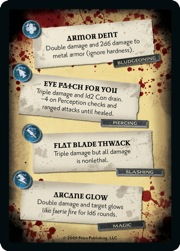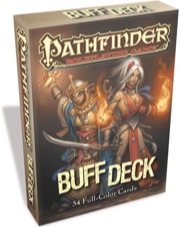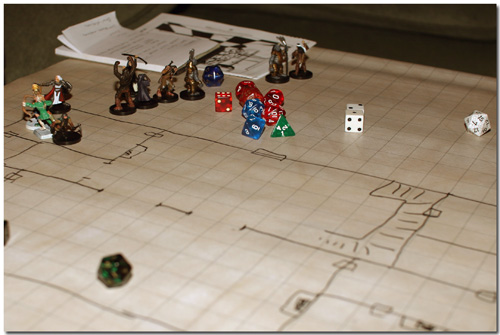On Combat as War or When Things Go Wahoo!
Wizards of the Coast's announcement that a new edition of D&D was in the works and would include a public play test period sparked a lot of vigorous debate on the internet. I've written about it before elsewhere so I won't belabor the point with my feelings about it (let's say lots of schadenfreude as I watch 4e fans work themselves into a froth). But at least one very interesting thing came out of these discussions. Someone theorized why 4e went over well with some people while not with others, and his thought was it depended on whether or not you viewed the fights in the game as Combat as Sport or Combat as War.
This idea may depend a lot on remember how 4e is promoted in its own literature and what it grew out of. D&D, in 4e, is heavily focused on The Encounter as the unit around which virtually everything revolves. There's a lot of emphasis on getting encounters designed in interesting ways, balanced ways, with fancy terrain and mixed units of enemies. Character abilities are often focused on the encounter as well - usable once per encounter and recharging when the encounter is over. This made me feel that 4e, more than any previous edition, was a lot like a fight bill for Wrestlemania. What's the next relatively closely seeded match? That's the essence of Combat as Sport - relatively balanced and relatively fresh teams squaring off in a prepared testing ground, consequences holding over from one match to another are relatively minimal. The DM acts as referee, but has a lot of rules to govern pretty much everything that could happen, in part because there are rule structures to help with oddball situations, but also because the player characters have powers that are fairly narrowly defined and limited in scope.
Combat as War, by contrast, doesn't worry about extending consequences nor about balance, per se. There may be balanced encounters, but part of the charm is bringing in tactics and plans, many of which require substantial DM adjudication, to do whatever it takes to resolve the encounter. If the player characters can unbalance the situation in their favor, that's fine, in fact it's probably a good idea. Characters have much wider ranges with some of their powers and abilities with fewer guidelines for how to limit them to level-appropriate or balanced results. If the party wizard wants to use a fireball spell to start a grass or forest fire and burn out the bandit encampment without facing so much risk, great. It's definitely not a question of a balanced match of the day on a prepared field. It may start that way (because every encounter is set up by the DM at some point), but it isn't expected to stay that way. The gloves come off and we see how things play out. The players apply whatever Wahoo they think they can.
In the Council of Thieves game I run, the players did something modestly Wahoo that I don't think 4e could have really done. It made perfect sense for them to do it given the powers they had, but it ran roughshod over any semblance of balance in the encounter. And it was glorious.
At one point in the campaign, a potential ally of the player characters is besieged out in the wilderness by a small army that includes bandits, ogres, and giants. That would be a tough group for four characters to take on, particularly with the giants. So the characters are well-advised to find other allies and bring them into the fight. One of those allies is a giant bombardier beetle - a gargantuan creature that can really much through the opposition. If they activate it and send it at the camp, it causes substantial chaos, enough to get them about a quarter of the way to forcing the besieging army to pack it in and leave. That's if they send it off and let it do its thing in an abstract, DM-narrated sort of way. But my players did something different, they went with it, literally riding it into battle to give it some slinger support. They also used some magic to make it even more formidable (barkskin and mage armor, to be precise, improving its Armor Class by 7 or 8 points). The rogues could hardly hit it (I had to roll a 20 on a d20 to get a hit). Even the giants throwing boulders needed a 20 to hit. That beetle was hell on wheels. It totally messed with the balance of the encounter but the players also clearly had a good time with it.
It's events like this, going a bit Wahoo, that make me all the happier that I decided to shift to playing Pathfinder rather than continue on with an edition of D&D that doesn't really support that kind of play - one in which the balance matters less than having things work based on how you think they should no matter how unbalanced the consequences.
If balanced combats are your thing, and there's nothing wrong with that, 4e's certainly not a bad game for it. But I don't really feel that's what D&D's always been about. Combats figure heavily, sure, but even more important is the conceit D&D (and now Pathfinder) has that the game is more than that. It's an epic story with heroic people, not just a sequence of balanced matches. Honestly, when I feel the urge to play a more balanced combat game, I turn to the superhero genre. That's a far better fit, if you ask me, than D&D has ever been.
This idea may depend a lot on remember how 4e is promoted in its own literature and what it grew out of. D&D, in 4e, is heavily focused on The Encounter as the unit around which virtually everything revolves. There's a lot of emphasis on getting encounters designed in interesting ways, balanced ways, with fancy terrain and mixed units of enemies. Character abilities are often focused on the encounter as well - usable once per encounter and recharging when the encounter is over. This made me feel that 4e, more than any previous edition, was a lot like a fight bill for Wrestlemania. What's the next relatively closely seeded match? That's the essence of Combat as Sport - relatively balanced and relatively fresh teams squaring off in a prepared testing ground, consequences holding over from one match to another are relatively minimal. The DM acts as referee, but has a lot of rules to govern pretty much everything that could happen, in part because there are rule structures to help with oddball situations, but also because the player characters have powers that are fairly narrowly defined and limited in scope.
Combat as War, by contrast, doesn't worry about extending consequences nor about balance, per se. There may be balanced encounters, but part of the charm is bringing in tactics and plans, many of which require substantial DM adjudication, to do whatever it takes to resolve the encounter. If the player characters can unbalance the situation in their favor, that's fine, in fact it's probably a good idea. Characters have much wider ranges with some of their powers and abilities with fewer guidelines for how to limit them to level-appropriate or balanced results. If the party wizard wants to use a fireball spell to start a grass or forest fire and burn out the bandit encampment without facing so much risk, great. It's definitely not a question of a balanced match of the day on a prepared field. It may start that way (because every encounter is set up by the DM at some point), but it isn't expected to stay that way. The gloves come off and we see how things play out. The players apply whatever Wahoo they think they can.
In the Council of Thieves game I run, the players did something modestly Wahoo that I don't think 4e could have really done. It made perfect sense for them to do it given the powers they had, but it ran roughshod over any semblance of balance in the encounter. And it was glorious.
At one point in the campaign, a potential ally of the player characters is besieged out in the wilderness by a small army that includes bandits, ogres, and giants. That would be a tough group for four characters to take on, particularly with the giants. So the characters are well-advised to find other allies and bring them into the fight. One of those allies is a giant bombardier beetle - a gargantuan creature that can really much through the opposition. If they activate it and send it at the camp, it causes substantial chaos, enough to get them about a quarter of the way to forcing the besieging army to pack it in and leave. That's if they send it off and let it do its thing in an abstract, DM-narrated sort of way. But my players did something different, they went with it, literally riding it into battle to give it some slinger support. They also used some magic to make it even more formidable (barkskin and mage armor, to be precise, improving its Armor Class by 7 or 8 points). The rogues could hardly hit it (I had to roll a 20 on a d20 to get a hit). Even the giants throwing boulders needed a 20 to hit. That beetle was hell on wheels. It totally messed with the balance of the encounter but the players also clearly had a good time with it.
It's events like this, going a bit Wahoo, that make me all the happier that I decided to shift to playing Pathfinder rather than continue on with an edition of D&D that doesn't really support that kind of play - one in which the balance matters less than having things work based on how you think they should no matter how unbalanced the consequences.
If balanced combats are your thing, and there's nothing wrong with that, 4e's certainly not a bad game for it. But I don't really feel that's what D&D's always been about. Combats figure heavily, sure, but even more important is the conceit D&D (and now Pathfinder) has that the game is more than that. It's an epic story with heroic people, not just a sequence of balanced matches. Honestly, when I feel the urge to play a more balanced combat game, I turn to the superhero genre. That's a far better fit, if you ask me, than D&D has ever been.







